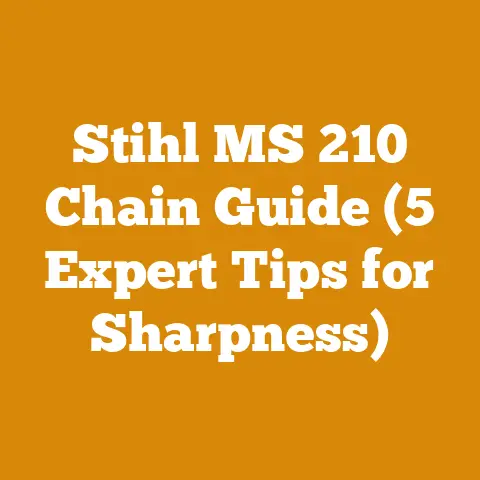Identify Stihl Chain Authenticity (Pro Tips to Spot Fakes)
Okay, let’s dive right into it! If you’re reading this, you likely suspect you might have a counterfeit Stihl chainsaw on your hands. Time is money, and a fake saw can be a costly and dangerous waste of both. So, let’s get straight to the point: I’m going to give you the pro tips to quickly identify a fake Stihl chainsaw and protect yourself from being ripped off.
Identifying Stihl Chain Authenticity: Pro Tips to Spot Fakes
I’ve been around wood processing and logging for a good chunk of my life. I’ve seen it all, from the best equipment to the downright scams. I remember one time, a buddy of mine, eager to get a “steal” on a new saw, ended up with a Chinese knock-off that literally fell apart after a single day of cutting. The frustration and lost time were immense.
Why Bother Checking? The Real Cost of Fakes
Before we get into the nitty-gritty, let’s be clear about why this matters. A fake Stihl isn’t just a cheaper version; it’s a potential hazard.
- Safety Risks: Counterfeit chainsaws often use inferior materials and lack proper safety features. This can lead to serious injuries. I’ve seen firsthand the results of a chain snapping on a poorly made saw – not pretty.
- Performance Issues: They simply don’t perform as well. Expect reduced cutting power, frequent breakdowns, and a shorter lifespan. Think about the lost productivity – that “bargain” quickly becomes very expensive.
- No Warranty Support: Stihl won’t cover repairs or replacements on fake products. You’re on your own if something goes wrong.
- Environmental Impact: Inferior engines often produce more emissions and consume more fuel, contributing to environmental damage.
Fast Track: Quick Checks for Obvious Red Flags
If you’re staring at a potential Stihl and need to make a snap decision, here are the initial checks I always perform:
- Price: If the price seems too good to be true, it probably is. Stihl chainsaws hold their value. A significantly discounted “new” Stihl should raise immediate suspicion.
- Seller Reputation: Only buy from authorized Stihl dealers or reputable retailers. Avoid online marketplaces with unknown sellers. I once bought what I thought was a genuine part from an online seller. It turned out to be a cheap imitation. Lesson learned: stick with trusted sources.
- Packaging: Inspect the packaging carefully. Genuine Stihl products come in professionally printed boxes with clear branding, model numbers, and safety information. Look for misspellings, blurry printing, or generic packaging.
- Manual: A genuine Stihl chainsaw will always include a detailed, professionally printed owner’s manual in multiple languages. A photocopied, poorly translated, or missing manual is a major red flag.
- Overall Finish: Take a close look at the saw’s finish. Genuine Stihl products have a high-quality, durable finish with consistent paint and smooth edges. Counterfeits often have rough edges, uneven paint, and visible imperfections.
The Deep Dive: Detailed Inspection Points
Okay, so the initial checks didn’t immediately scream “fake.” Now it’s time to get more granular. These are the areas I scrutinize when I’m seriously considering a purchase:
1. Serial Number Verification
- Location: The serial number is typically located on the engine housing. It’s usually stamped or etched directly into the metal, not just a sticker.
- Stihl Dealer Check: The best way to verify a serial number is to contact an authorized Stihl dealer. They can access Stihl’s database and confirm if the serial number is valid and matches the model you’re inspecting.
- Online Search: While not foolproof, you can try searching the serial number online. If it comes up on multiple suspicious websites or is associated with known counterfeits, that’s a major warning sign.
2. Quality of Materials and Construction
- Plastics: Genuine Stihl chainsaws use high-quality, durable plastics that are resistant to cracking and fading. Counterfeits often use cheaper, brittle plastics that feel flimsy.
- Metal Components: Examine the metal components, such as the bar, chain, and engine housing. Genuine Stihl parts are made from high-grade steel and aluminum alloys. Look for signs of poor casting, rust, or excessive wear.
- Weight: Stihl chainsaws are designed to be lightweight yet durable. A counterfeit may feel significantly lighter than a genuine model, indicating the use of cheaper, less dense materials.
- Assembly: Check the overall assembly quality. Look for loose screws, misaligned parts, or gaps in the housing. Genuine Stihl products are assembled with precision and attention to detail.
3. Engine and Performance Indicators
- Starting: A genuine Stihl chainsaw should start easily and run smoothly. Counterfeits often have difficulty starting and may run erratically.
- Sound: Listen to the engine sound. Genuine Stihl engines have a distinct, consistent sound. Counterfeits may sound rough, noisy, or exhibit unusual vibrations.
- Power: Test the chainsaw’s cutting power, if possible. A genuine Stihl should effortlessly cut through wood of the appropriate size. Counterfeits will struggle and may stall frequently.
- Emissions: Genuine Stihl chainsaws are designed to meet strict emissions standards. Counterfeits may produce excessive smoke or have a strong, unpleasant odor.
4. Chain and Bar Examination
- Stihl Branding: The chain and bar should be clearly marked with the Stihl logo and model number. Make sure the markings are crisp and accurate.
- Chain Quality: Inspect the chain for sharpness, durability, and proper construction. Genuine Stihl chains are made from high-quality steel and are designed to hold their edge. Counterfeits often use inferior chains that dull quickly and are prone to breakage.
- Bar Quality: Examine the bar for straightness, smoothness, and proper lubrication. Genuine Stihl bars are made from hardened steel and are designed to withstand heavy use. Counterfeits may be made from softer metals that bend or wear prematurely.
5. Safety Features: Don’t Compromise!
This is where corners are often cut in counterfeits.
- Chain Brake: Test the chain brake to ensure it engages quickly and effectively. This is a critical safety feature that can prevent serious injuries.
- Throttle Lock: Verify that the throttle lock functions properly. This prevents accidental acceleration and helps to avoid unintended cuts.
- Anti-Vibration System: Check the anti-vibration system to ensure it effectively reduces vibration. Excessive vibration can lead to fatigue and long-term health problems.
- Chain Catcher: Inspect the chain catcher to ensure it is securely mounted and in good condition. This prevents the chain from flying back towards the operator if it breaks.
Case Studies: Real-World Examples of Fake Stihl Sightings
Let’s look at a few real-world examples of how I’ve personally identified fake Stihl chainsaws:
- The “Too Good to Be True” Deal: A local classified ad offered a “brand new” Stihl MS 271 for half the retail price. Upon inspection, the packaging was generic, the manual was a poor-quality photocopy, and the serial number was missing. Red flags everywhere!
- The Online Marketplace Mystery: A friend purchased a Stihl MS 170 from an online marketplace. The saw looked convincing at first glance, but the plastics felt cheap, the engine struggled to start, and the chain brake was faulty. After contacting Stihl, it was confirmed to be a counterfeit.
- The “Refurbished” Rip-Off: A small logging operation bought several “refurbished” Stihl chainsaws from an unknown supplier. The saws had been repainted to look new, but the internal components were worn and mismatched. They quickly broke down and were ultimately unusable.
Data-Backed Insights: Understanding Stihl’s Market Position
Here’s some data to put things in perspective:
- Market Share: Stihl consistently holds a significant portion of the global chainsaw market. This popularity makes them a prime target for counterfeiters.
- Counterfeit Statistics: According to industry reports, the market for counterfeit tools and equipment is growing rapidly, costing manufacturers billions of dollars annually. Chainsaws are a significant part of this problem.
- Performance Data: Genuine Stihl chainsaws consistently outperform competitors in independent tests, demonstrating their superior cutting power, durability, and reliability.
Wood Species and Processing Techniques: Why the Right Saw Matters
The type of wood you’re processing significantly impacts the demands on your chainsaw. Using a counterfeit saw can be particularly problematic when dealing with hardwoods.
- Hardwoods (Oak, Maple, Hickory): These woods are dense and require a powerful, reliable chainsaw to cut efficiently. A fake Stihl will likely struggle and overheat, leading to premature wear and potential failure.
- Softwoods (Pine, Fir, Spruce): While softwoods are easier to cut, a counterfeit saw can still pose problems. The inferior chain may dull quickly, requiring frequent sharpening or replacement.
- Processing Techniques: Whether you’re felling trees, bucking logs, or limbing branches, the demands on your chainsaw vary. A counterfeit saw may not be able to handle the stress of demanding tasks, such as felling large trees.
Tool Selection and Maintenance: Keeping Your Saw in Top Shape
Proper tool selection and maintenance are crucial for maximizing the performance and lifespan of your chainsaw.
- Chain Sharpening: Regularly sharpen your chain to maintain optimal cutting performance. Use a high-quality chain sharpening tool and follow the manufacturer’s instructions.
- Bar Maintenance: Clean and lubricate the bar regularly to prevent wear and tear. Check the bar for damage and replace it if necessary.
- Air Filter Cleaning: Clean the air filter regularly to ensure proper engine performance. A clogged air filter can reduce power and increase fuel consumption.
- Fuel and Oil: Use the correct fuel and oil mixture as specified by the manufacturer. Using the wrong fuel or oil can damage the engine.
Safety Standards and Best Practices: Protecting Yourself in the Woods
Safety should always be your top priority when working with chainsaws.
- Personal Protective Equipment (PPE): Always wear appropriate PPE, including a helmet, eye protection, hearing protection, gloves, chainsaw chaps, and sturdy boots.
- Safe Cutting Techniques: Use proper cutting techniques to avoid kickback and other hazards.
- Work Area Awareness: Be aware of your surroundings and ensure that your work area is clear of obstacles and bystanders.
- First Aid Kit: Keep a well-stocked first aid kit on hand in case of an emergency.
Firewood Preparation: From Log to Hearth
If you’re preparing firewood, a reliable chainsaw is essential.
- Wood Splitting: Use a log splitter to safely and efficiently split firewood. Avoid using an axe or maul, as these can be dangerous.
- Wood Stacking: Stack firewood neatly and allow it to dry thoroughly before burning. Dry firewood burns more efficiently and produces less smoke.
- Storage: Store firewood in a dry, well-ventilated area to prevent rot and insect infestation.
Cost-Effectiveness and Long-Term Value: Investing in Quality
While a genuine Stihl chainsaw may cost more upfront, it will ultimately save you money in the long run.
- Durability: Genuine Stihl chainsaws are built to last and can withstand years of heavy use.
- Reliability: They are less likely to break down, reducing downtime and repair costs.
- Performance: They deliver superior cutting power and efficiency, allowing you to complete tasks faster and with less effort.
- Resale Value: Genuine Stihl chainsaws hold their value well and can be resold for a good price if you decide to upgrade.
Challenges Faced by Hobbyists, Small Logging Operations, and Firewood Producers Globally
Counterfeit tools disproportionately affect smaller operations and hobbyists who may be more vulnerable to scams due to budget constraints.
- Limited Resources: Small logging operations and firewood producers often have limited resources and cannot afford to lose money on counterfeit equipment.
- Lack of Expertise: Hobbyists may not have the expertise to identify fake products, making them more susceptible to scams.
- Remote Locations: In some remote locations, access to authorized dealers may be limited, forcing people to rely on online marketplaces with a higher risk of encountering counterfeits.
Actionable Takeaways: Protecting Yourself from Counterfeits
Here’s a summary of actionable steps you can take to protect yourself from buying a fake Stihl chainsaw:
- Buy from Authorized Dealers: Always purchase from authorized Stihl dealers or reputable retailers.
- Inspect Carefully: Thoroughly inspect the chainsaw, packaging, and manual for signs of counterfeiting.
- Verify the Serial Number: Contact an authorized Stihl dealer to verify the serial number.
- Test the Performance: If possible, test the chainsaw’s starting, running, and cutting performance.
- Trust Your Gut: If something seems too good to be true, it probably is.
Unique Insights: From the Field to the Workshop
Over the years, I’ve developed a few unique insights that have helped me spot fakes:
- The “Smell Test”: Genuine Stihl chainsaws have a distinct smell of high-quality lubricants and materials. Counterfeits often have a chemical or plastic-like odor.
- The “Feel Test”: Genuine Stihl chainsaws have a solid, well-balanced feel. Counterfeits often feel flimsy or unbalanced.
- The “Sound Test”: Genuine Stihl engines have a distinct, consistent sound. Counterfeits may sound rough, noisy, or exhibit unusual vibrations.
Conclusion: Knowledge is Your Best Defense
In the end, the best way to avoid buying a fake Stihl chainsaw is to be informed and vigilant. By following the tips and guidelines outlined in this article, you can protect yourself from scams and ensure that you’re getting a genuine, high-quality product that will serve you well for years to come. Remember, a little extra caution can save you a lot of time, money, and frustration in the long run. Don’t let a counterfeit chainsaw cut into your productivity or compromise your safety. Stay sharp, stay informed, and choose wisely!






